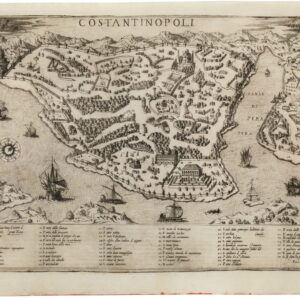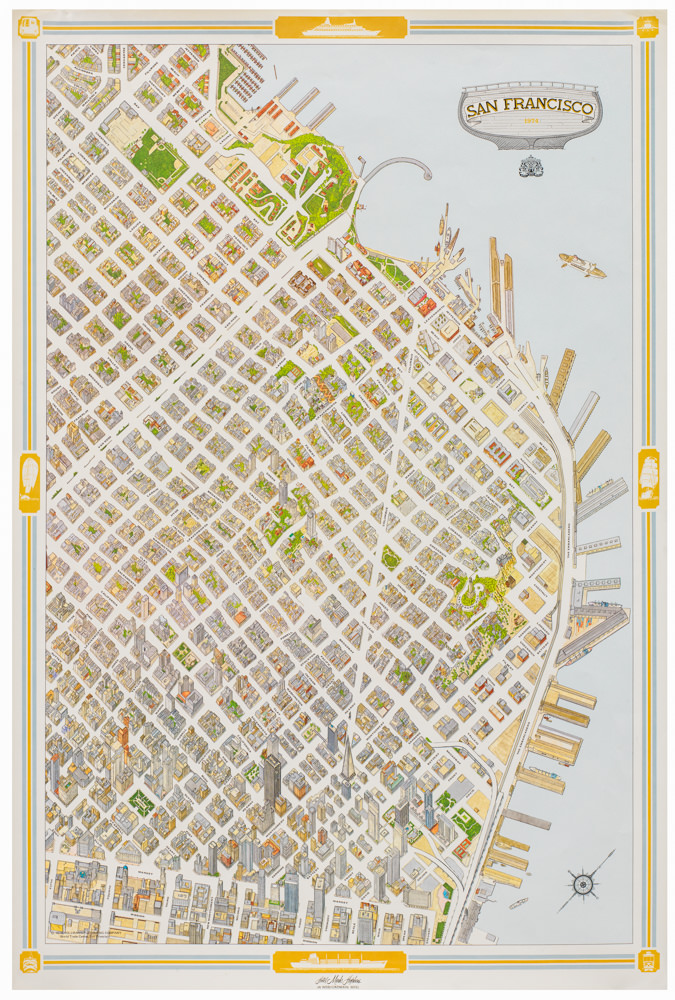1638 Merian panorama of Paris — first plate with a self-portrait.
Parys.
$1,500
1 in stock
Description
Matthaus Merian’s panoramic view of Paris, looking southwest from the Parc des Buttes Chaumont hills above the city. Prominently featured at center is the Hôpital Saint-Louis, built in 1611 by architect Claude Vellefaux on orders of King Henry IV of France.
In the foreground we see a depiction of Merian himself, sitting on a rock and sketching the view. Nearby are the Latin words “Matt. Merian ad vivid delineav” — it is this inscription that both informs us that this is a self-portrait, but also marks the view as published by Matthaus, rather than his son Caspar Merian. When Caspar re-engraved the view in a second plate, he removed the words “ad vivid.”
Beyond the Hôpital Saint-Louis we see the city of Paris itself, with famous monuments like the Notre Dame and Bastille clearly visible. This is the city under Louis XIII, at a time when Cardinal Richelieu was a powerful force. It is a city familiar to the modern viewer, oddly recognizable despite the centuries that separate the two.
Cartographer(s):
Matthäus Merian (September 1593 – 19 June 1650) was a Swiss-born engraver who worked in Frankfurt for most of his career, where he also ran a publishing house. He was a member of the patrician Basel Merian family.
Early in his life, he had created detailed town plans in his own unique style, for example plans of both Basel and Paris (1615). With Martin Zeiler (1589 – 1661), a German geographer, and later (circa 1640) with his own son, Matthäus Merian produced a collection of topographic maps. The 21-volume set was collectively known as the Topographia Germaniae and included numerous town-plans and views, as well as maps of most countries and a world map. The work was so popular that it was re-issued in many editions. He also took over and completed the later parts and editions of the Grand Voyages and Petits Voyages, originally started by Theodor de Bry in 1590. Merian’s work inspired the Swedish royal cartographer, Erik Dahlberg, to produce his Suecia Antiqua et Hodierna, which became a cornerstone in European mapping.
After his death, his sons Matthäus Jr. and Caspar took over the publishing house. They continued publishing the Topographia Germaniae and the Theatrum Europaeum under the name ‘Merian Erben’ (i.e. Heirs of Merian). Today, the German travel magazine Merian is named after him.
Condition Description
A 3-inch wedge in the lower left has been reinstated by expert facsimile. Wear along the centerfold and some other scattered blemishes. Else very good.
References



![PORT OF SAN FRANCISCO. WHERE THE FAR EAST BEGINS [Japanese language version]](https://neatlinemaps.com/wp-content/uploads/2021/01/NL-00879_Thumbnail-300x300.jpg)
![PORT OF SAN FRANCISCO. WHERE THE FAR EAST BEGINS [Japanese language version]](https://neatlinemaps.com/wp-content/uploads/2021/01/NL-00879_Thumbnail.jpg)

